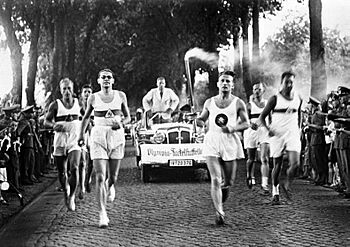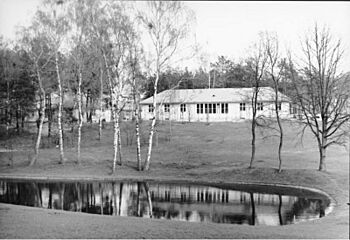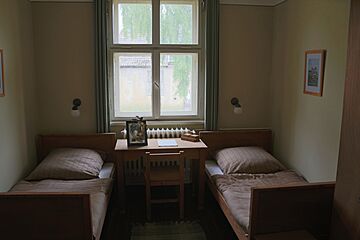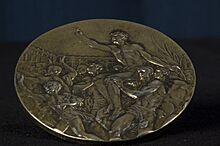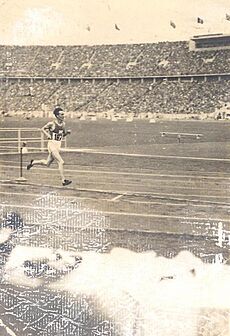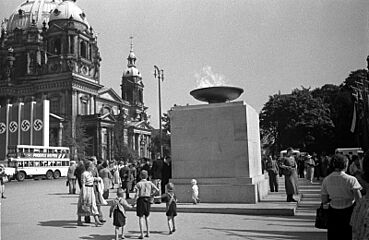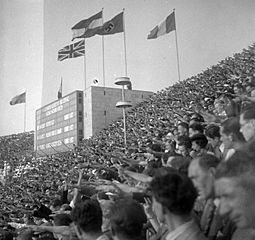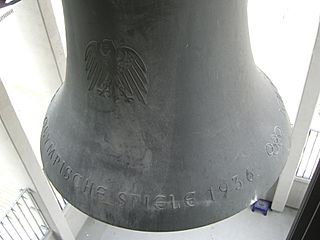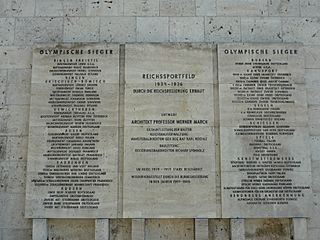1936 Summer Olympics facts for kids

Emblem of the 1936 Summer Olympics
|
|||
| Host city | Berlin, Germany | ||
|---|---|---|---|
| Motto | I Call the Youth of the World! (German: Ich rufe die Jugend der Welt!) |
||
| Nations | 49 | ||
| Athletes | 3,963 (3,632 men, 331 women) | ||
| Events | 129 in 19 sports (25 disciplines) | ||
| Opening | 1 August 1936 | ||
| Closing | 16 August 1936 | ||
| Opened by | |||
| Cauldron |
Fritz Schilgen
|
||
| Stadium | Olympiastadion | ||
| Summer | |||
|
|||
| Winter | |||
|
|||
The 1936 Summer Olympics (German: Olympische Sommerspiele 1936), officially known as the Games of the XI Olympiad (German: Spiele der XI. Olympiade) and commonly known as Berlin 1936, was an international multi-sport event held from 1 to 16 August 1936 in Berlin, Germany. Berlin won the bid to host the Games over Barcelona at the 29th IOC Session on 26 April 1931. The 1936 Games marked the second and most recent time the International Olympic Committee gathered to vote in a city that was bidding to host those Games. Later rule modifications forbade cities hosting the bid vote from being awarded the games.
To outdo the 1932 Los Angeles Games, Reichsführer Adolf Hitler had a new 100,000-seat track and field stadium built, as well as six gymnasiums and other smaller arenas. The Games were the first to be televised, with radio broadcasts reaching 41 countries. Filmmaker Leni Riefenstahl was commissioned by the German Olympic Committee to film the Games for $7 million. Her film, titled Olympia, pioneered many of the techniques now common in the filming of sports.
Hitler saw the 1936 Games as an opportunity to promote his government and ideals of racial supremacy and antisemitism, and the official Nazi Party paper, the Völkischer Beobachter, wrote in the strongest terms that Jews should not be allowed to participate in the Games. German Jewish athletes were barred or prevented from taking part in the Games by a variety of methods, although some female swimmers from the Jewish sports club Hakoah Vienna did participate. Jewish athletes from other countries were said to have been sidelined to avoid offending the Nazi regime. Lithuania was expelled from the Olympic Games due to Berlin's position regarding Lithuanian anti-Nazi policy, particularly because of the Trial of Neumann and Sass in Klaipėda, Lithuania, in 1934–1935.
Total ticket revenues were 7.5 million Reichsmark, for a profit of over one million R.M. The official budget did not include outlays by the city of Berlin (which issued an itemized report detailing its costs of 16.5 million R.M.) or the outlays of the German national government (which did not make its costs public, but is estimated to have spent US$30 million).
Jesse Owens of the United States won four gold medals in the sprint and long jump events, and became the most successful athlete to compete in Berlin, while Germany was the most successful country overall with 101 medals (38 of them gold); the United States placed a distant second with 57 medals. These were the final Olympic Games under the presidency of Henri de Baillet-Latour. For the next 12 years, no Olympic Games were held due to the immense world disruption caused by the Second World War. The next Olympic Games were held in 1948 (the Winter Games in St. Moritz, Switzerland and then the Summer Games in London, England, United Kingdom).
Contents
Host city selection
At the 28th IOC Session, held in 1930 in Berlin, 14 cities announced their intention to bid to host the 1936 Summer Olympic Games. The bidding for these Olympic Games was the first to be contested by IOC members casting votes for their own favorite host cities.
The vote occurred on 26 April 1931, at the 29th IOC Session held in Barcelona, Spain that year. The vote was held 69 days after the declaration of the Second Spanish Republic and during the final years of the Weimar Republic. This was two years before Adolf Hitler and the Nazi Party rose to power in Germany, in 1933.
By the time of the 1931 IOC Session, only Barcelona and Berlin were left in contention for the delegate vote. Rome withdrew on the eve of the vote. The process by which the other candidate cities were withdrawn from consideration for the 1936 Summer Olympics is unclear. Additionally, the level of seriousness behind each other city's declared intention to bid is also uncertain.
The other cities that announced an intention to hold the games, but which withdrew from the race, were Alexandria, Budapest, Buenos Aires, Cologne, Dublin, Frankfurt, Helsinki, Lausanne, Montevideo, Nuremberg, Rio de Janeiro, and Rome. Helsinki, Rome, Barcelona and Rio de Janeiro would go on to host the Olympic Games in 1952, 1960, 1992 and 2016, respectively.
The selection procedure marked the second and final time that the International Olympic Committee would gather to vote in a city which was bidding to host those Games. The only other time this occurred was at the inaugural IOC Session in Paris, France, on 24 April 1894. Then, Athens and Paris were chosen to host the 1896 and 1900 Games, respectively.
The city of Barcelona held a multi-sport festival at the same time as the 1931 IOC Session. This included a football match between Spain and the Irish Free State, which was watched by 50,000 spectators. The political uncertainty around the declaration of the Second Spanish Republic, which had happened days before the IOC Session, was likely a great factor in the decision taken by delegates regarding the host city for 1936. Berlin prevailed.
After the Nazis took control of Germany, and began instituting anti-Semitic policies, the IOC held private discussions among its delegates about changing the decision to hold the Games in Berlin. However, Hitler's regime gave assurances that Jewish athletes would be allowed to compete on a German Olympic team. One year before the games, the American Olympic Association suggested to change the venue to Rome; they saw Rome as a good replacement because Rome was originally selected to hold the 1908 Summer Olympics.
| City | Country | Round 1 |
|---|---|---|
| Berlin | 43 | |
| Barcelona | 16 | |
| Abstentions | 8 | |
| Withdrawn bids | ||
| Alexandria | 0 | |
| Budapest | 0 | |
| Buenos Aires | 0 | |
| Cologne | 0 | |
| Dublin | 0 | |
| Frankfurt | 0 | |
| Helsinki | 0 | |
| Lausanne | 0 | |
| Montevideo | 0 | |
| Nuremberg | 0 | |
| Rio de Janeiro | 0 | |
| Rome | 0 | |
Organization
Hans von Tschammer und Osten, as Reichssportführer (i.e., head of the National Socialist League of the Reich for Physical Exercise (Deutscher Reichsbund für Leibesübungen, DRL), the Reich Sports Office, played a major role in the structure and organisation of the Olympics. He promoted the idea that the use of sports would harden the German spirit and instill unity among German youth. At the same time he also believed that sports was a "way to weed out the weak, Jewish, and other undesirables".
Von Tschammer trusted the details of the organisation of the games to Theodor Lewald and Carl Diem, the former president and secretary of the Deutscher Reichsausschuss für Leibesübungen, the forerunner of the Reich Sports Office. Among Diem's ideas for the Berlin Games was the introduction of the Olympic torch relay between Greece and the host nation.
Torch relay
The 1936 Summer Olympics torch relay was the first of its kind, following on from the reintroduction of the Olympic Flame at the 1928 Games. It pioneered the modern convention of moving the flame via a relay system from Greece to the Olympic venue. Leni Riefenstahl filmed the relay for the 1938 film Olympia.
The sportive, knightly battle awakens the best human characteristics. It doesn't separate, but unites the combatants in understanding and respect. It also helps to connect the countries in the spirit of peace. That's why the Olympic Flame should never die.
Broadcasting
The games were the first to have live television coverage in black-and-white. The German Post Office, using equipment from Telefunken, broadcast over 70 hours of coverage to special viewing rooms throughout Berlin and Potsdam and a few private TV sets, transmitting from the Paul Nipkow TV Station. They used three different types of TV cameras, so blackouts would occur when changing from one type to another. The games were also first time photographed and filmed in color using newly invented Agfacolor.
Olympic village
The 1936 Olympic village was located at Elstal in Wustermark (at 52°32′10.78″N 13°0′33.20″E / 52.5363278°N 13.0092222°E), on the western edge of Berlin. The site, which is 30 kilometres (19 mi) from the centre of the city, consisted of one and two-floor dormitories, a large dining hall, Dining Hall of the Nations, a swimming facility, gymnasium, track, and other training facilities. Its layout was designed and construction overseen by appointed village commander Hauptmann Wolfgang Fürstner beginning in 1934. Less than two months before the start of the Olympic Games, Fürstner was abruptly demoted to vice-commander, and replaced by Oberstleutnant Werner von Gilsa, commander of the Berlin Guard-Regiment. The official reason for the replacement was that Fürstner had not acted "with the necessary energy" to prevent damage to the site as 370,000 visitors passed through it between 1 May and 15 June. However, this was just a cover story to explain the sudden demotion of the half-Jewish officer. The 1935 Nuremberg Laws, passed during the period Fürstner was overseeing the Olympic Village, had classified him as a Jew, and as such, the career officer was to be expelled from the Wehrmacht. Two days after the conclusion of the Berlin Olympics, vice-commander Fürstner had been removed from active Wehrmacht duty.
After the completion of the Olympic Games, the village was repurposed for the Wehrmacht into the Olympic Döberitz Hospital (German: Olympia-Lazarett Döberitz), and Army Infantry School (German: Heeres-Infanterieschule), and was used as such through the Second World War. In 1945 it was taken over by the Soviet Union and became a military camp of the Soviet occupation forces. Late 20th-century efforts were made to restore parts of the former village, but little progress was made. More recently, the vast majority of the land of the Olympic village has been managed by the DKB Foundation, with more success; efforts are being made to restore the site into a living museum. The dormitory building used by Jesse Owens, Meissen House, has been fully restored, with the gymnasium and swimming hall partially restored. Seasonally, tours are given daily to small groups and students.
The site remains relatively unknown even in Germany, but some tournaments are held at the site in an effort to boost knowledge of the venues.
-
LZ 129 Hindenburg flying over the village, with the Olympics logo painted on its underside hull
Venues
Twenty-two venues were used for the 1936 Summer Olympics. Many were located in the Reich Sportsfeld complex.
Sailing was held in the Bay of Kiel, which would serve as the same sporting venue for the 1972 Summer Olympics held in Munich. The Olympic Stadium would later be part of two FIFA World Cups and then host an IAAF World Championships in Athletics along with undergoing a renovation in the early 2000s to give new life to the stadium. Avus Motor Road (AVUS) was started in 1907, but was not completed until 1921 due to World War I. The track was rebuilt for the 1936 Games. AVUS continued being used after World War II though mainly in Formula 2 racing. The German Grand Prix was last held at the track in 1959. Dismantling of the track first took place in 1968 to make way for a traffic crossing for touring cars that raced there until 1998.
BSV 92 Field was first constructed in 1910 for use in football, handball, athletics, and tennis. The Reich Sports Field, which consisted of the Olympic Stadium, the Dietrich Eckert Open-Air Theatre, the Olympic Swimming Stadium, Mayfield, the Hockey Stadiums, the Tennis Courts, and the Haus des Deutschen Sports, was planned for the aborted 1916 Summer Olympics, but was not completed until 1934. Mayfield was the last venue completed prior to the 1936 Games in April 1936. Deutschland Hall was opened in 1935. Mommenstadion opened in 1930. Basketball was held outdoors at the request of the International Basketball Federation (FIBA). The tennis courts were used, which turned to mud during heavy rain at the final. The K-1 1000 m canoeing final was also affected by heavy rain at Grünau that included thunder and lightning. During World War II, Deutschlandhalle in Berlin, suffered heavy aerial bombing damage. After the war, the hall was reconstructed and expanded. The Deutschlandhalle was used as a venue, but was increasingly closed for repairs, last in 2009. It was demolished in December 2011. The Mommsenstadion was renovated in 1987 and was still in use as of 2010[update].
The Olympic Stadium was used as an underground bunker in World War II as the war went against Nazi Germany's favor. The British reopened the Stadium in 1946 and parts of the stadium were rebuilt by the late 1950s. As a host venue for the 1974 FIFA World Cup, the stadium had its roof partially covered on the North and South Stands. British occupation of the stadium ended in 1994. Restoration was approved in 1998 with a contractor being found to do the work in 2000. This restoration ran from 2000 to 2004. The modernized Stadium reopened in 2004, with a capacity of 74,228 people. The seating has been changed greatly, especially the sections that were reserved for German and international political leaders. The stadium now plays host to Hertha BSC (1963–present), and is expected to remain the home of the team for years to come. For the 2006 FIFA World Cup, the venue was where the final took place between Italy and France. Three years later, the venue hosted the World Athletics Championships.
| Venue | Sports | Capacity | Ref. |
|---|---|---|---|
| Avus Motor Road | Athletics (marathon, 50 km walk), Cycling (road) | Not listed | |
| BSV Field | Cycling (track), Handball | 1,000 | |
| Dietrich Eckart Open-Air Theatre | Gymnastics | 20,000 | |
| Döberitz | Equestrian (eventing), Modern pentathlon (riding) | Not listed | |
| Deutschlandhalle | Boxing, Weightlifting, Wrestling | 8,630 | |
| Berlin-Grünau Regatta Course | Canoeing, Rowing | 19,000 | |
| Haus des Deutschen Sports | Fencing, Modern pentathlon (fencing) | 1200 | |
| Hertha BSC Field | Football | 35,239 | |
| Hockeystadion | Field hockey | 18,000 | |
| Hockeystadion#2 | Field hockey | 1600 | |
| Kiel Bay | Sailing | Not listed | |
| Mayfield | Equestrian (dressage), Polo | 75,000 | |
| Mommsenstadion | Football | 15,005 | |
| Olympic Stadium | Athletics, Equestrian (jumping), Football (final), Handball (final) | 100,000 | |
| Olympic Swimming Stadium | Diving, Modern pentathlon (swimming), Swimming, Water polo | 20,000 | |
| Police Stadium | Handball | Not listed | |
| Poststadion | Football | 45,000 | |
| Ruhleben | Modern pentathlon (shooting) | Not listed | |
| Tennis Courts | Basketball, Fencing (épée) | 832 | |
| Tennis Stadium | Basketball | Not listed | |
| Wannsee Golf Course | Modern pentathlon (running) | Not listed | |
| Wannsee Shooting Range | Shooting | Not listed |
Games
Opening ceremony
The opening ceremony was held at the Berlin Olympic Stadium on 1 August 1936. A flyover by the German airship Hindenburg flying the Olympic flag behind it was featured early in the opening ceremonies. After the arrival of Hitler and his entourage, the parade of nations proceeded, each nation with its own unique costume. As the birthplace of the Olympics, Greece entered the stadium first. The host nation, Germany, entered last. Some nations' athletes purposefully gave the Nazi salute as they passed Hitler. Others gave the Olympic salute (a similar one, given with the same arm), or a different gesture entirely, such as hats-over-hearts, as the United States, India, and China did. All nations lowered their flags as they passed the Führer, save the United States, the United Kingdom, Switzerland and the Commonwealth of the Philippines. (The United States doing this was explained later as an army regulation.) Writer Thomas Wolfe, who was there, described the opening as an "almost religious event, the crowd screaming, swaying in unison and begging for Hitler. There was something scary about it; his cult of personality."
After a speech by the president of the German Olympic Committee, the games were officially declared open by Adolf Hitler who quoted (in German): "I proclaim open the Olympic Games of Berlin, celebrating the Eleventh Olympiad of the modern era." This sentence was written by IOC President Baillet-Latour as part of a compromise the IOC struck to prevent Hitler from turning the speech into a propaganda event, and he was to follow it strictly, to which Hitler reportedly joked "Count, I'll take the trouble to learn it by heart". Hitler opened the games from his own box, on top of others. Writer David Wallechinsky has commented on the event, saying, "This was his event, he wanted to be glorified."
Although the Olympic flame was first introduced in the 1928 Summer Olympics in Amsterdam, this was the first instance of the torch relay. The Nazis invented the concept of the torch run from ancient Olympia to the host city. Thus as swimmer Iris Cummings later related, "once the athletes were all in place, the torch bearer ran in through the tunnel to go around the stadium". A young man chosen for this task ran up the steps all the way up to the top of the stadium there to light a cauldron which would start this eternal flame that would burn through the duration of the games.
But in spite of all the pomp and ceremony, and the glorification of Hitler, all did not go according to plan, and there was a rather humorous aspect in the opening ceremony. U.S. distance runner Louis Zamperini, one of the athletes present, related it on camera:
They released 25,000 pigeons, the sky was clouded with pigeons, the pigeons circled overhead, and then they shot a cannon, and they scared the poop out of the pigeons, and we had straw hats, flat straw hats, and you could heard the pitter-patter on our straw hats, but we felt sorry for the women, for they got it in their hair, but I mean there were a mass of droppings, and I say it was so funny...
Events
129 events in 25 disciplines, comprising 19 sports, were part of the Olympic program in 1936. The number of events in each discipline is noted in parentheses.
- Aquatics
- Diving (4)
- Swimming (11)
- Water polo (1)
- Athletics (29)
- Basketball (1)
- Boxing (8)
- Canoeing (9)
- Cycling
- Road (2)
- Track (4)
- Equestrian
- Dressage (2)
- Eventing (2)
- Show jumping (2)
- Fencing (7)
- Field hockey (1)
- Football (1)
- Gymnastics (9)
- Handball (1)
- Modern pentathlon (1)
- Polo (1)
- Rowing (7)
- Sailing (4)
- Shooting (3)
- Weightlifting (5)
- Wrestling
- Freestyle (7)
- Greco-Roman (7)
Basketball, canoeing, and handball made their debut at the Olympics. Handball did not appear again on the program until the next German summer Olympic games in Munich in 1972. There were two demonstration sports: baseball and gliding. Art competitions for medals were also held, and medals were awarded at the closing ceremony for feats of alpinism and aeronautics.
A team from India gave demonstrations of traditional Indian sports such as kabaddi, kho kho and mallakhamb, but were not part of India's official Olympic contingent. A team from China performed a wushu exhibition. In addition, an Olympic Rally for automobiles was run alongside the Games.
Notable achievements
Germany had a successful year in the equestrian events, winning individual and team gold in all three disciplines, as well as individual silver in dressage. In the cycling match sprint finals, the German Toni Merkens fouled Arie van Vliet of the Netherlands. Instead of being disqualified, he was fined 100 ℛℳ and kept his gold. German gymnasts Konrad Frey and Alfred Schwarzmann both won three gold medals.
American Jesse Owens won four gold medals in the sprint and long jump events. His German competitor Luz Long offered Owens advice after he almost failed to qualify in the long jump and was posthumously awarded the Pierre de Coubertin medal for sportsmanship. Mack Robinson, brother of Jackie Robinson, won the 200-meter sprint silver medal behind Owens by 0.4 seconds. Although he did not win a medal, future American war hero Louis Zamperini, lagging behind in the 5,000-meter final, made up ground by clocking a 56-second final lap. In one of the most dramatic 800-meter races in history, American John Woodruff won gold after slowing to jogging speed in the middle of the final in order to free himself from being boxed in. Glenn Edgar Morris, a farm boy from Colorado, won gold in the decathlon. British rower Jack Beresford won his fifth Olympic medal in the sport, and his third gold medal. The U.S. eight-man rowing team from the University of Washington won the gold medal, coming from behind to defeat the Germans and Italians with Hitler in attendance. 13-year-old American sensation Marjorie Gestring won the women's 3 meter diving event.
Jack Lovelock of New Zealand won the 1500 m gold medal, coming through a strong field to win in world record time of 3:47.8.
In the marathon, the ethnic Koreans Sohn Kee-chung and Nam Sung-yong won one gold and one bronze medal; as Korea was annexed by Japan at the time, they were running for Japan.
India won the gold medal in the field hockey event once again (they won the gold in all Olympics from 1928 to 1956), defeating Germany 8–1 in the final. Indians were considered Indo-Aryans by the German authorities and there was no controversy regarding the victory.
Rie Mastenbroek of the Netherlands won three gold medals and a silver in swimming. Estonian heavyweight wrestler Kristjan Palusalu won two gold medals, he became the first and only wrestler in Olympic history ever to win both the Greco-Roman and freestyle heavyweight events. Berlin 1936 marked the last time Estonia competed as an independent nation in the Olympics until 1992.
After winning the middleweight class, the Egyptian weightlifter Khadr El Touni continued to compete for another 45 minutes, finally exceeding the total of the German silver medalist by 35 kg. The 20-year-old El Touni lifted a total of 387.5 kg, crushing two German world champions and breaking the then-Olympic and world records, while the German lifted 352.5 kg. Furthermore, El Touni had lifted 15 kg more than the light-heavyweight gold medalist, a feat only El Touni has accomplished. El Touni's new world records stood for 13 years. Fascinated by El Touni's performance, Adolf Hitler rushed down to greet this human miracle. Prior to the competition, Hitler was said to have been sure that Rudolf Ismayr and Adolf Wagner would embarrass all other opponents. Hitler was so impressed by El Touni's domination in the middleweight class that he ordered a street named after him in Berlin's Olympic village. The Egyptian held the No. 1 position on the IWF list of history's 50 greatest weightlifters for 60 years, until the 1996 Games in Atlanta where Turkey's Naim Süleymanoğlu surpassed him to top the list.
Italy's football team continued their dominance under head coach Vittorio Pozzo, winning the gold medal in these Olympics between their two consecutive World Cup victories (1934 and 1938). Much like the successes of German athletes, this triumph was claimed by supporters of Benito Mussolini's regime as a vindication of the superiority of the fascist system. Austria won the silver; a controversial win after Hitler called for a rematch of the quarterfinals match to discount Peru's 4–2 win over Austria. The Peruvian national Olympic team refused to play the match again and withdrew from the games. In the quarter-finals of the football tournament, Peru beat Austria 4–2 in extra-time. Peru rallied from a two-goal deficit in the final 15 minutes of normal time. During extra-time, Peruvian fans allegedly ran onto the field and attacked an Austrian player. In the chaos, Peru scored twice and won, 4–2. However, Austria protested and the International Olympic Committee ordered a replay without any spectators. The Peruvian government refused and their entire Olympic squad left in protest as did Colombia.
A remarkable story from the track and field competition was the gold medal won by the US women's 4 × 100 m relay team. The German team were the heavy favourites, but dropped the baton at one hand-off. Of notable interest on the US team was Betty Robinson. She was the first woman ever awarded an Olympic gold medal for track and field, winning the women's 100 m event at the 1928 Summer Olympics in Amsterdam. In 1931, Robinson was involved in a plane crash, and was severely injured. Her body was discovered in the wreckage and it was wrongly thought that she was dead. She was placed in the trunk of a car and taken to an undertaker, where it was discovered that she was not dead, but in a coma. She awoke from the coma seven months later, although it was another six months before she could get out of a wheelchair, and two years before she could walk normally again. Due to the length of her recovery, she had to miss participating in the 1932 Summer Olympics in Los Angeles, in her home country.
Participating nations
A total of 49 nations attended the Berlin Olympics, up from 37 in 1932. Five nations made their first official Olympic appearance at these Games: Afghanistan, Bermuda, Bolivia, Costa Rica and Liechtenstein.
-
1936 Summer Olympics numbers.png
Number of attending athletes from respective participating countries.
| Participating National Olympic Committees |
|---|
|
 Haiti, also took part in the Opening Ceremony, but its only athlete (a weightlifter) did not compete.
Haiti, also took part in the Opening Ceremony, but its only athlete (a weightlifter) did not compete.
Medal count
The twelve nations that won the most medals at the 1936 Games.
* Host nation ( Germany)
| Rank | Nation | Gold | Silver | Bronze | Total |
|---|---|---|---|---|---|
| 1 | 38 | 31 | 32 | 101 | |
| 2 | 24 | 20 | 12 | 56 | |
| 3 | 10 | 1 | 5 | 16 | |
| 4 | 9 | 13 | 5 | 27 | |
| 5 | 8 | 6 | 6 | 20 | |
| 6 | 7 | 6 | 6 | 19 | |
| 7 | 6 | 5 | 10 | 21 | |
| 8 | 6 | 4 | 10 | 20 | |
| 9 | 6 | 4 | 7 | 17 | |
| 10 | 5 | 7 | 5 | 17 | |
| 11 | 4 | 7 | 3 | 14 | |
| 12 | 1 | 9 | 5 | 15 | |
| Totals (12 nations) | 124 | 113 | 106 | 343 | |
Last surviving competitor
Upon the death of Joan Langdon on 15 March 2022, Iris Cummings became the last surviving competitor of the 1936 Summer Olympics.
Gallery
-
Spectators giving the Nazi salute during one of the medal ceremonies as the Nazi flag flies above
See also
 In Spanish: Juegos Olímpicos de Berlín 1936 para niños
In Spanish: Juegos Olímpicos de Berlín 1936 para niños
- 1936 Winter Olympics
- Olympic Games celebrated in Germany
- 1936 Winter Olympics – Garmisch-Partenkirchen
- 1936 Summer Olympics – Berlin
- 1972 Summer Olympics – Munich
- List of IOC country codes
- Olympic Games Decoration
- Race (2016 film)
- National Socialist League of the Reich for Physical Exercise


